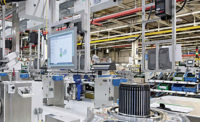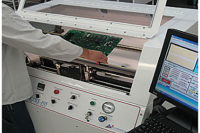Like desktop computer users, manufacturers know all too well the problem of planned obsolescence. This happens when a new operating system is intentionally designed to be incompatible with various older software programs. However, manufacturers also have to deal with host platform obsolescence, which occurs when a newer I/O control module is unable to support an older version of a manufacturer’s product.
For quite a while, Speedline Technologies Inc. faced this problem when updating modules for its Electrovert line of PCB assembly equipment. But, that all changed several years ago when the company had Sensoray develop the Model 2600 I/O module series for use with Speedline’s wave soldering, reflow soldering and precision cleaning machines.
Unlike most modules, which are based on ever-evolving expansion bus standards, the 2600 series is based on the Ethernet. As a result, the series works with virtually every hardware platform on the market today and should remain viable for the foreseeable future, according to Greg Calvo, product manager for Speedline.
He says Speedline requested the series have two specific design features. One is plug-and-play simplicity. The other is an interface that connects very close to the machines. This allows for the use of short cables, resulting is more accurate measurements and less electrical noise being picked up.
Speedline installs 10 to 12 modules in every machine. Each module transfers thousands of data bits per second between sensors, controllers and operating systems. Within the wave soldering machine, for example, the heating module controls several heaters, each of which features a cable-attached sensor that turns the heater on and off. Other modules control motors and conveyor systems.
The 2600 module series is often used with a Model 2601 communication device, also from Sensoray. This device distributes power, interlock signals and communications to as many as 16 I/O modules. It also features four RS-232/422/485 ports for communicating with serial devices such as bar code scanners.
Aware that electronics manufacturers demand reliable equipment, Sensoray designed the modules so operators can quickly replace them when they fail. The modules snap onto standard 35-millimeter DIN rails and connect directly to I/O boards with field wiring, eliminating the need for external termination boards. Calvo notes that the modules’ open-frame design also improves overall serviceability, and allows for easier training of assemblers and service technicians.
The 2600 series modules are equally effective for industrial process control, building automation and data acquisition applications. They even enable a manufacturer to monitor and control the I/O system over a LAN with a remote computer. Standard features include an integral power distribution system and safety interlock circuitry.
For more information on OEM electronics, call 503-684-8005 or visit www.sensoray.com.




